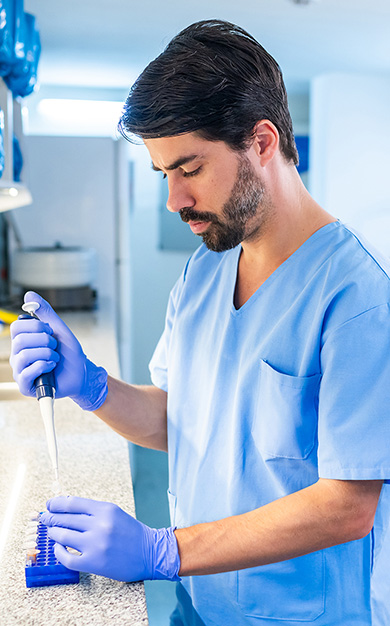Successful Cell Transplantation Gives Hope for New Glaucoma Treatment
Written By: BrightFocus Editorial Staff
Written By: BrightFocus Editorial Staff
Learn about the first successful attempt to transplant lab-grown retinal ganglion cells (RGCs) into the eyes of mice to find a cure for glaucoma.
What: Researchers have reported the first successful attempt to transplant lab-grown retinal ganglion cells (RGCs) derived from induced pluripotent stem cells (iPSCs) into the eyes of mice. Based on this work in animal models, they estimate that humans with late-stage glaucoma could begin receiving vision-restoring transplants in the next 10 years.
Where: Oswald J, et al. Transplantation of miPSC/mESC-Derived Retinal Ganglion Cells Into Healthy and Glaucomatous Retinas. Molecular Therapy: Methods & Clinical Development, June, 2021.
BrightFocus Connection: This research was supported by a 2020 BrightFocus National Glaucoma Research grant awarded to Petr Baranov, MD, PhD, the study’s lead author, at the Schepens Eye Research Institute at Harvard Medical School (see link to grant profile below).
Why It Is Important: A collaborative team of researchers have made the first successful attempt to transplant lab-grown RGCs derived from stem cells into the eyes of mice. RGCs are the nerve cells that transmit visual information from the eye to the brain. When a critical number of these cells becomes destroyed by glaucoma, vision loss results.
Interestingly, they found that the transplanted donor cells, which were grown in petri dishes, integrated themselves into the diseased retinas of recipient mice and survived there for up to a year. Induced pluripotent stem cells (iPSCs) are specially cultured stem cells obtained from adult human cells that can be programmed to become one of many cell types – in this case, RGCs.
Moreover, researchers re-isolated the transplanted donor cells from the host retina both one day and one week after transplant and studied their gene transcription by a technique called single-cell RNA sequencing. The results showed that, once transplanted, the donor cells were able to express markers that indicated that they can connect and communicate with other retinal nerve cells in the host tissue. Identifying these markers will help researchers better understand ways to make the transplanted cells function properly and improve vision.
According to the authors, practical applications of RGC transplantation in humans depends on the availability of a robust, scalable source of human RGCs for transplant. And because the eye rarely rejects transplanted cells, transplant candidates would not need to receive RGCs grown from their own stem cells. Instead, human RGCs could be grown from iPSCs provided by a universal donor and stored frozen in a cell bank to be thawed and transplanted when needed.
BrightFocus Foundation is a premier global nonprofit funder of research to defeat Alzheimer’s, macular degeneration, and glaucoma. Since its inception more than 50 years ago, BrightFocus and its flagship research programs—Alzheimer’s Disease Research, Macular Degeneration Research, and National Glaucoma Research—has awarded more than $300 million in research grants to scientists around the world, catalyzing thousands of scientific breakthroughs, life-enhancing treatments, and diagnostic tools. We also share the latest research findings, expert information, and resources to empower the millions impacted by these devastating diseases. Learn more at brightfocus.org.
Disclaimer: The information provided here is a public service of BrightFocus Foundation and is not intended to constitute medical advice. Please consult your physician for personalized medical, dietary, and/or exercise advice. Any medications or supplements should only be taken under medical supervision. BrightFocus Foundation does not endorse any medical products or therapies.

Schepens Eye Research Institute of Massachusetts Eye and Ear
Support Groundbreaking Glaucoma Research
Your support helps fund critical research that could prevent vision loss, provide valuable information to the public, and cure this sight-stealing disease.
Donate Today